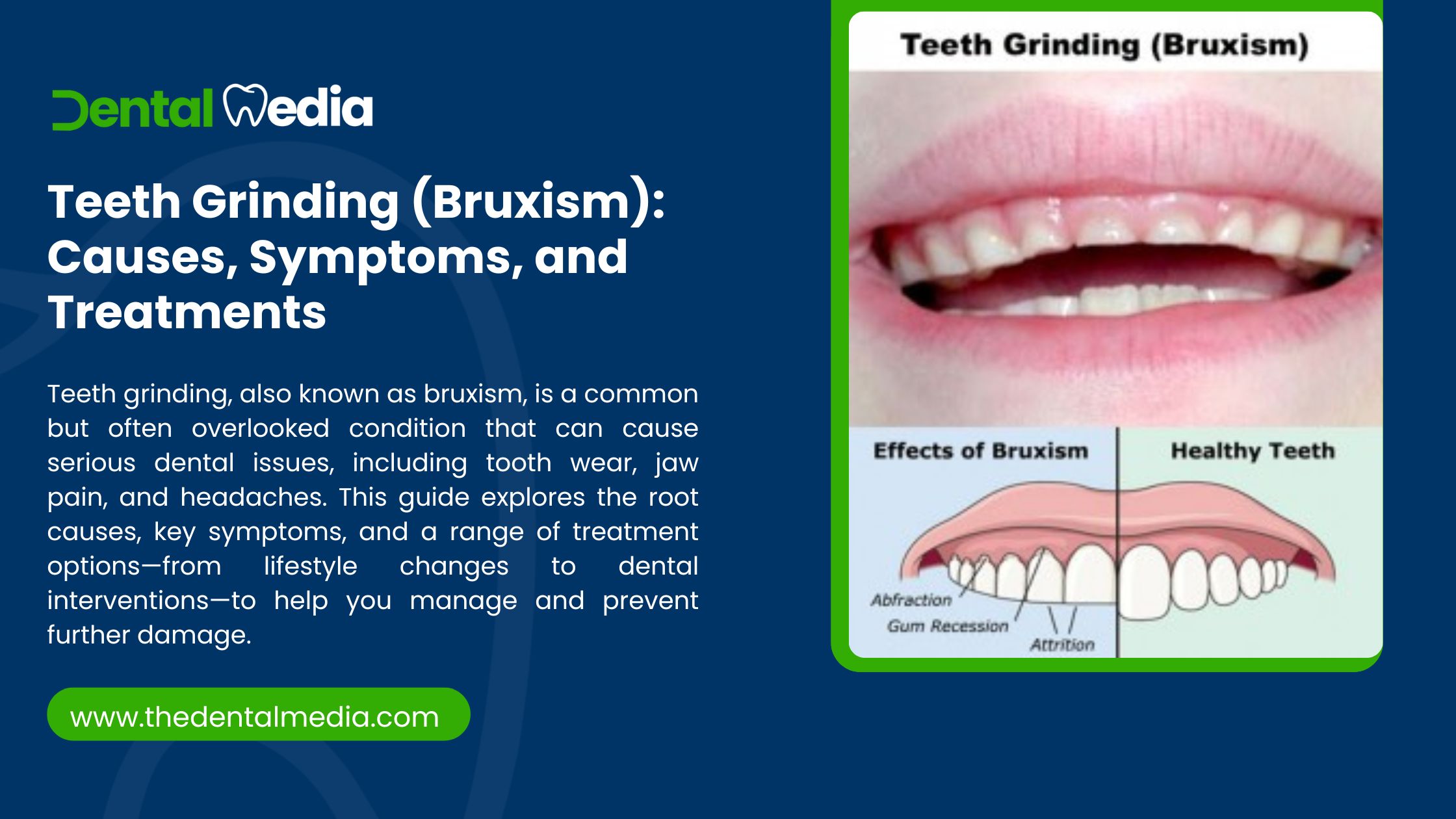Teeth grinding, medically known as bruxism, is a common but often underdiagnosed condition where individuals grind, gnash, or clench their teeth—often unknowingly. It can occur during the day (awake bruxism) or at night while sleeping (sleep bruxism). Though occasional teeth grinding may not cause harm, persistent or severe cases can lead to serious complications such as tooth damage, jaw disorders, headaches, and sleep disturbances. Understanding the causes, recognizing the symptoms, and seeking timely treatment can prevent long-term dental and medical issues.
What is Bruxism?
Bruxism is a repetitive jaw-muscle activity involving clenching, grinding, or bracing of the teeth. It can happen:
- Involuntarily during sleep (most common)
- Consciously or subconsciously while awake, often during stress or concentration
There are two main types:
- Sleep Bruxism – Occurs during sleep; considered a sleep-related movement disorder
- Awake Bruxism – Usually linked to stress, anxiety, or concentration
Causes of Teeth Grinding
Bruxism can be caused by various physical, psychological, and lifestyle factors. Often, it’s a combination of several.
Psychological Factors
- Stress and Anxiety: Major contributors, especially for awake bruxism
- Tension and Anger: Unresolved emotions can trigger unconscious grinding
- Sleep Disorders: Bruxism is commonly associated with sleep apnea, snoring, or disrupted sleep cycles
Physical Factors
- Misaligned Teeth or Bite (Malocclusion): May cause the jaw to overcompensate during rest
- Neurological Conditions: Parkinson’s disease, Huntington’s disease, and others have been linked to bruxism
- Genetics: Family history can increase the risk of sleep bruxism
Lifestyle Factors
- Caffeine and Alcohol Use: These substances can increase muscle activity during sleep
- Smoking: Nicotine stimulates muscles, which may heighten grinding
- Certain Medications: Especially SSRIs (e.g., fluoxetine, sertraline) and some antipsychotics
Common Symptoms of Bruxism
Bruxism often goes unnoticed until symptoms become severe or a dentist detects tooth damage. Symptoms can vary depending on whether bruxism occurs during the day or at night.
Dental Symptoms
- Worn-down teeth or flattened biting surfaces
- Chipped, cracked, or loose teeth
- Increased tooth sensitivity
- Damaged dental restorations (fillings, crowns, bridges)
Jaw and Facial Symptoms
- Jaw pain or stiffness (especially upon waking)
- Clicking or popping in the jaw (may signal TMJ disorder)
- Lockjaw or limited jaw movement
- Enlarged jaw muscles (hypertrophy)
Other Symptoms
- Headaches (especially near temples)
- Earaches (without ear infection)
- Disrupted sleep (waking up feeling unrefreshed)
- Pain in the neck or shoulders
Diagnosis of Bruxism
Bruxism is typically diagnosed by a dentist or sleep specialist, often based on symptoms, dental wear patterns, and patient history.
Diagnostic Methods:
- Clinical Examination: Dentists look for signs of wear, jaw tenderness, and gum recession
- Patient Interviews: To assess stress levels, sleep habits, and symptom history
- Sleep Study (Polysomnography): Recommended for sleep bruxism, especially if linked to sleep apnea
- Bite Tests & X-rays: To evaluate jaw alignment and detect TMJ involvement
Treatment Options for Bruxism
Treatment for bruxism depends on the severity, underlying cause, and whether it is sleep or awake bruxism.
Dental Treatments
Mouthguards or Splints
- Custom-fitted nightguards protect teeth from grinding damage
- They don’t stop grinding but reduce wear and prevent injuries
Bite Adjustment
- Involves reshaping teeth to improve alignment (occlusal equilibration)
- In some cases, orthodontic treatment may be recommended
Repairing Damage
- Crowns, bonding, or veneers may be needed to restore damaged teeth
Behavioral and Lifestyle Therapies
Stress Management
- Cognitive-behavioral therapy (CBT)
- Relaxation techniques (deep breathing, meditation, yoga)
- Biofeedback therapy: Helps patients become aware of grinding/clenching patterns
Habit-Reversal Techniques
- In awake bruxism, awareness training can help stop clenching
- Chewing sugar-free gum or placing the tongue on the roof of the mouth to relax the jaw
Medical and Pharmacological Treatments
Muscle Relaxants
- Temporarily used to relax jaw muscles before bedtime
Botox Injections
- Used for severe cases where other treatments have failed
- Temporarily weakens the jaw muscles to reduce grinding intensity
Changing Medications
- If bruxism is medication-induced, a doctor may recommend alternatives
Bruxism in Children
Children also experience bruxism, particularly during growth phases.
Common Causes:
- Misaligned teeth
- Anxiety or hyperactivity
- New teeth erupting
- Allergies or ENT issues
Most children outgrow bruxism without treatment, but severe cases may need:
- Nightguards (in older children)
- Stress reduction techniques
- Monitoring by a pediatric dentist
Potential Complications of Untreated Bruxism
Ignoring bruxism can lead to serious oral and overall health problems:
- Chronic headaches and migraines
- Severe tooth damage requiring root canals or extractions
- Temporomandibular Joint Disorder (TMJD)
- Sleep disturbances (for both the patient and their partner)
- Facial pain or altered facial structure due to muscle overuse
Prevention Tips
While not all cases are preventable, you can take steps to reduce risk:
- Manage stress and anxiety proactively
- Avoid caffeine and alcohol, especially in the evening
- Get enough sleep and establish a calming nighttime routine
- Visit your dentist regularly for early detection
- Use relaxation or jaw exercises to reduce muscle tension
- Avoid chewing gum or pens—it reinforces the clenching habit
For more help and support, feel free to contact us at TheDentalMedia.com.

